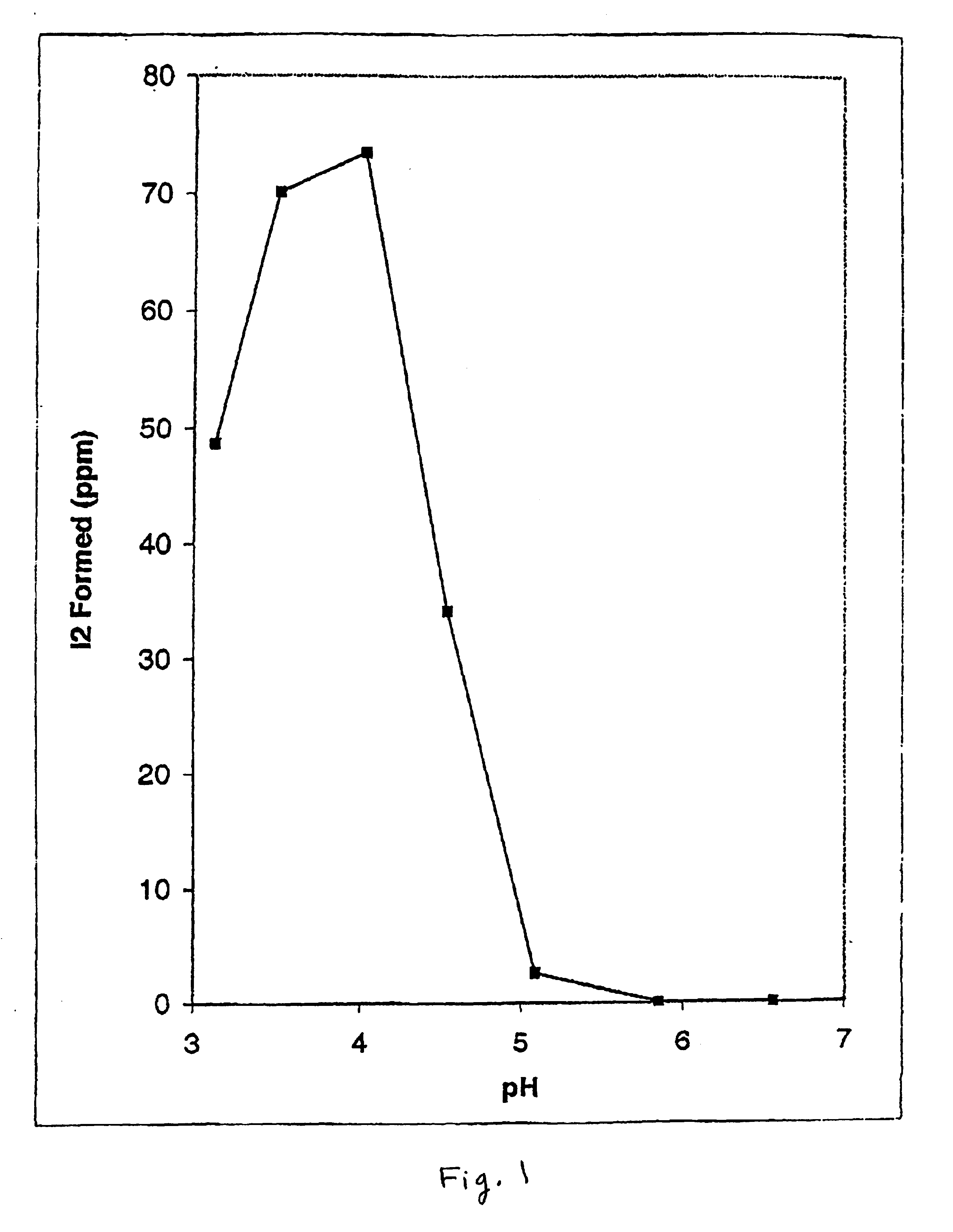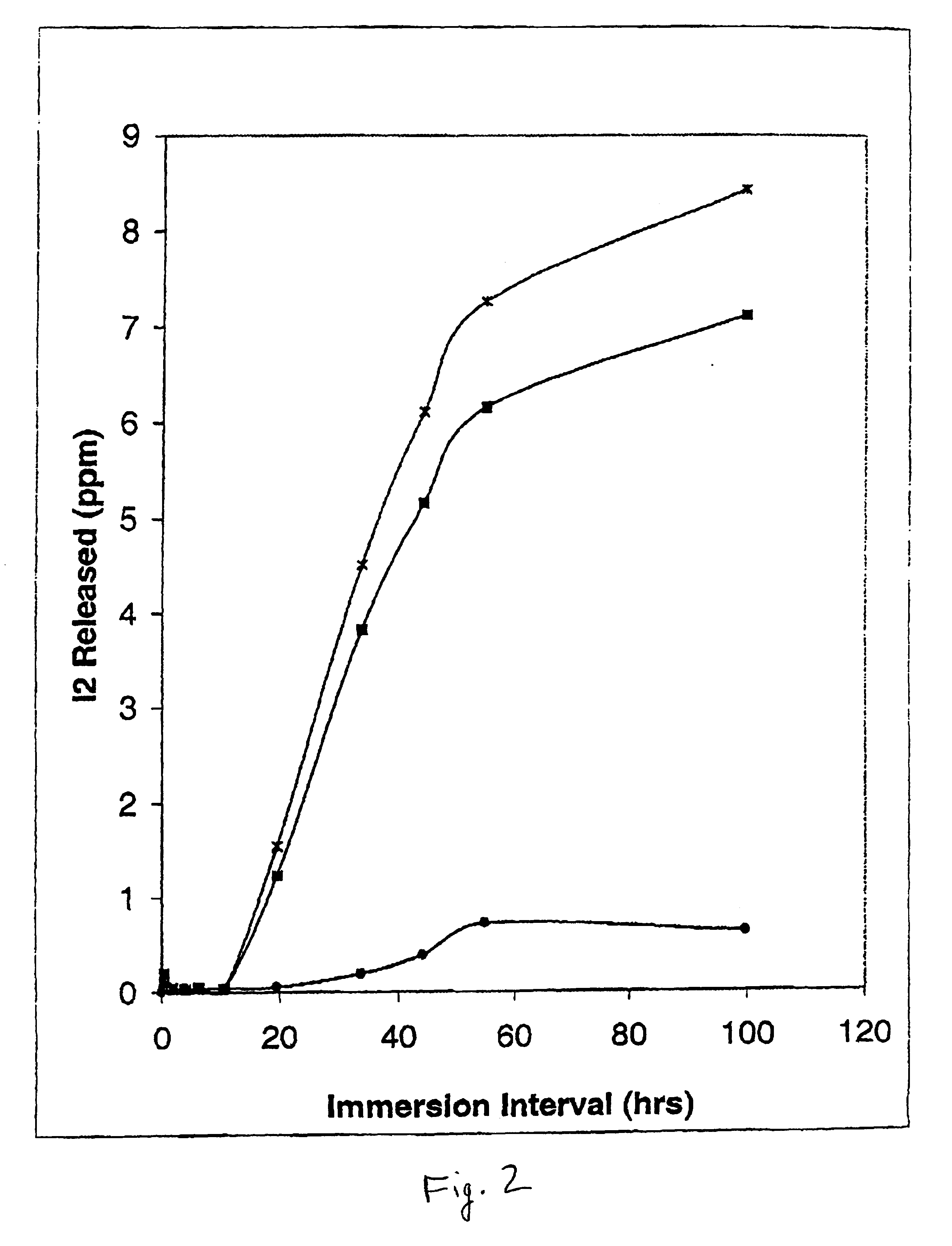Methods and devices for providing anti-infective activity to a medical device
- Summary
- Abstract
- Description
- Claims
- Application Information
AI Technical Summary
Benefits of technology
Problems solved by technology
Method used
Image
Examples
specific examples
Example 1
Effect of pH on De Novo Formation of Elemental Iodine Produced from Inorganic Iodide and Iodate. FIG. 1 shows the effect of varying the pH of buffered citrate solutions (50 mM) on the rate of free elemental iodine formation using potassium iodide and sodium iodate as precursors. Iodine was quantitated as the triiodide complex formed by transfer of aliquots of test reaction mixtures to stock 10 mM potassium iodide made up in distilled water measured at 350 nm on a double-beam UV-265 double beam Shimadzu spectrometer. A calibration curve was prepared using crystalline iodine dissolved in the same stock potassium iodide solution. Citrate buffered solutions were made up to known pH values as indicated, determined by titration and measurement on a standard pH meter. Aliquots of the citrate buffered solutions were mixed with silicone discs impregnated with a mixture of 2% potassium iodide and 10% sodium iodate (by weight relative to the disc). Following varying incubation periods...
example 2
Egress of Iodine from Polyvinylchloride (PVC)-Loaded Catheter Tubing by ICAT. FIG. 2 shows the recovery of iodine released from PVC tubing preloaded with varying concentrations of iodine using in-situ chemical anti-infective loading technology (ICAT) for iodine generating formulations versus immersion times of the catheter in fluid. Five cm lengths of PVC tubing (outer diameter, 5.5 mm; inner diameter, 3.0 mm) were preloaded with iodine generating formulations made up of parts A and B in which the final concentration of inorganic sodium iodide ranged from 2.5 (solid circles), to 12.5 mM (solid squares) to 50 mM (“x” symbols), respectively. The final concentration of Carbopol C971 PNF was made up as 0.25%, and sodium iodate was held constant at 12.5 mM. The pH of the iodine generating formulation was 4.6. Immediately after preloading the inner lumen of the PVC tubing, the ends were capped with glass rods (total ICAT loading volume, 0.353 ml), and the catheter tubing was rinsed with d...
example 3
Uptake and Transport of Free Iodine into the Catheter Wall of ICAT-Loaded PVC Tubing. FIG. 3 shows the corresponding uptake of free iodine formed with loading of ICAT into the same PVC tubing using an identical experimental setup as in Example 2. In these experiments, ICAT loading was made using a final concentration of sodium iodide of 25 mM with sodium iodate held constant at 12.5 mM, Carbopol C971 PNF held at 0.25%, and the final pH set at 4.6. Following end capping of the PVC catheter tubing, and rinsing of the capped tubing in distilled water, the tubing was again placed in 10 ml of 10 mM KI. However, rather than monitoring the egress of iodine, at the points indicated in FIG. 3, 10 μl aliquots of the ICAT fluid were withdrawn from the internal lumen and the level of free iodine in the latter solution determined following 100-fold dilution in 10 mM potassium iodide solution. The concentrations shown in FIG. 3 thus represent {fraction (1 / 100)}th of the actual concentration of fe...
PUM
 Login to View More
Login to View More Abstract
Description
Claims
Application Information
 Login to View More
Login to View More - R&D
- Intellectual Property
- Life Sciences
- Materials
- Tech Scout
- Unparalleled Data Quality
- Higher Quality Content
- 60% Fewer Hallucinations
Browse by: Latest US Patents, China's latest patents, Technical Efficacy Thesaurus, Application Domain, Technology Topic, Popular Technical Reports.
© 2025 PatSnap. All rights reserved.Legal|Privacy policy|Modern Slavery Act Transparency Statement|Sitemap|About US| Contact US: help@patsnap.com



